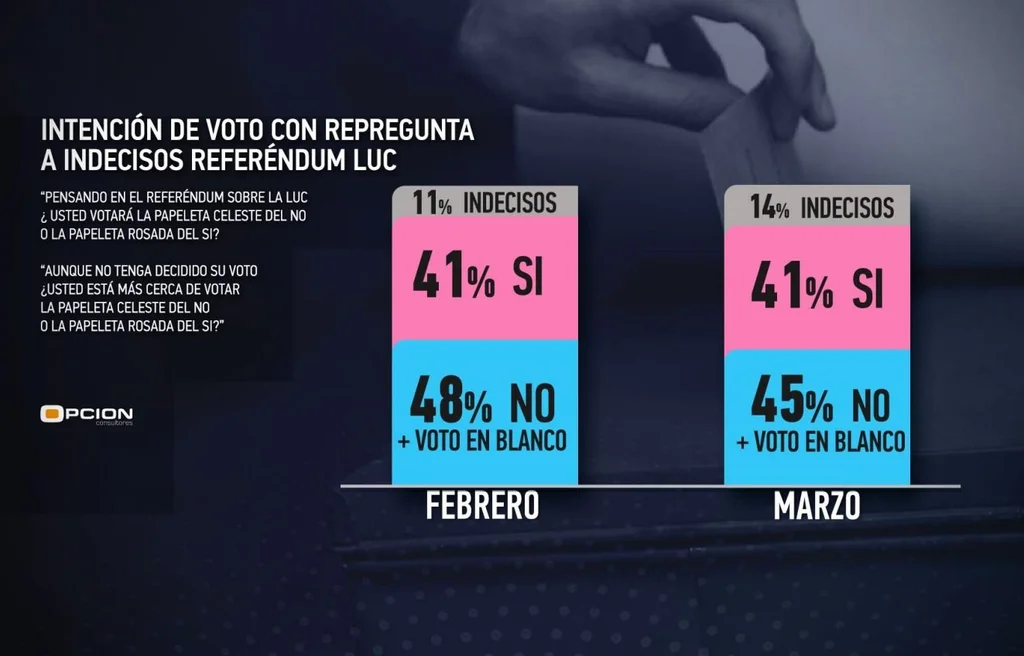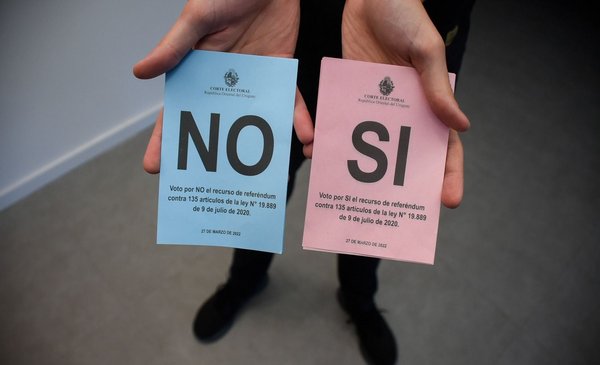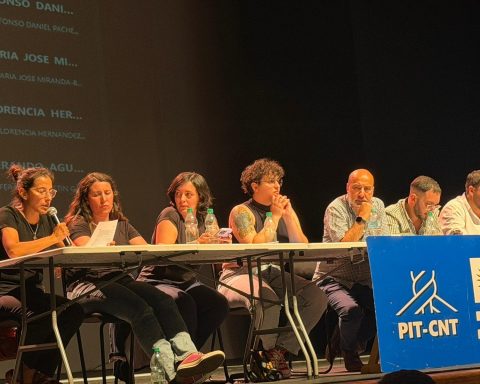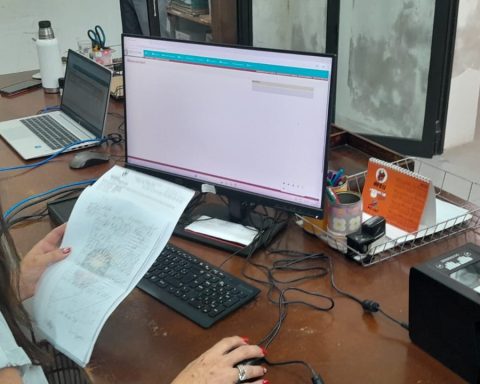The last Option Consultants survey before the March 27 referendum showed that 38% of Uruguayans lean towards No and 35% towards Yes, to which is added 1% who say they will vote blank, 2% who will annul the vote, 2% who will not vote and a The remaining 22% that have not defined their suffrage.
As in previous editions of its survey on the Law of Urgent Consideration (LUC), the consultant included a cross-question to the undecided asking which of the two options is considered closer. In this scenario, and taking into account only the valid votes, Option registered a 44% adherence for the No, 41% for the Yes and 14% of “hard” undecided, who do not show closeness with either of the two ballots.
Consultants Option
Consultants Option Plates presented at Telenoche
If you add 1% of the blank votes, which count for the No to the repeal of the 135 articles, the scenario on election days is 45% for No, 41% for Yes and 14% undecided.
The photo varies slightly with respect to February, when the Option survey, when questioning the undecided, showed 48% for No, 41% for Yes and 11% “hard” undecided.
According to the report, presented this Wednesday on Telenoche (Channel 4), that change of three points that went from No to undecided “may be a trend that reflects real changes in preferences in the electorate, fluctuations of the sample design or a combination of both phenomena”.

Consultants Option
Consultants Option Plates presented at Telenoche
The consultant adds that “comprehensively analyzing the set of data collected by Option both in this edition and throughout the entire campaign, it is concluded that the scenario is one of parity and uncertainty”, although it is not a stage “strictly symmetrical”.
“The No has maintained a slight advantage in our last three measurements and the Yes would require capturing a higher percentage of undecideds to achieve victory, approximately 60% of the total of undecideds and 64% if we only refer to the hard undecideds“, adds the report.
Four Reasons for “Caution”
In summary, Option points out that “there are about 3 out of 4 Uruguayans who have maintained a clear preference for one or another option for a long time, among whom NO has a small difference in their favor.” In the rest of the electorate “grossly speaking, the majority is made up of undecided voters (22%), divided between those who have an initial preference and those who could be baptized as the “hard core” of the undecided,” explains the consultant.

Consultants Option
Consultants Option Plates presented at Telenoche
“There are also three small segments, whose final behavior may be relevant in a context of high parity. In the first place, 1% would vote blank. Since the votes for Yes must beat the sum of the votes for No and blank votes, the effective distance between the option of repeal and the maintenance of the articles in dispute of the LUC is 4 points. In addition, 2% of voters would annul their vote (these votes will not be taken into account to resolve the result of the contest) and another 2% of citizens declare that they will not turn out to vote.This last category (which must be incorporated a few days before the election) is made up of a heterogeneous set of situations: voters who would need to move to another department to vote but do not plan to do so, elderly people with mobility problems and citizens who do not have a civic credential,” the report adds.
Option handles in addition four reasons to “assume caution and analytical prudence” prior to the election.
“First of all, in any survey the proportions or point estimates are subject to a confidence interval or statistical margin of error. In the case of the estimates towards the YES and NO of this survey, the margin of error is approximately + /- 3 percentage points for each option For example, in the case of the estimates with cross-examination of the undecided, the Interval of NO (including blank votes) is between 42% and 48%, while that of YES is between 38% and 44% For a confidence level of 95% and the referred margin of +/-3%, the differences recorded in this survey are therefore not statistically significant“, Explain.
Second, and as its director Rafael Porzecanski warned in an interview with The Observer, “in binary instances any transfer of votes from one option to another has a double effect”. “If, for example, there were a passage of 2 points of votes from YES to NO in recent days, the current distance of 4 points in favor of NO would be transformed into an advantage of 8 points. If the reverse were to happen, the 4 points in favor of the NO would become a tie. The evidence of public opinion from the last ballot suggests to be attentive to possible last-minute passages from one option to another, particularly among the undecided close to one of the alternatives,” says the report.
Thirdly, the Option report highlights that the final stretch is reached with “unprecedentedly high proportion of undecided”. “If we refer to the hard undecided, this percentage is between 4 and 7 points higher than that existing in the polls for the final week of the elections held in 2019. It is about a group of citizens who will make a decision in these last days (even the same Sunday) and who offer few signs to make an adequate projection of their eventual behavior: they are evenly divided in their political preferences (including a large percentage that do not identifies with neither of the two great blocs that divide the Uruguayan political system), they are little or not at all informed about the LUC and have a low level of involvement in political issues in general”, add.
Finally, the consultancy points out that the latest survey does not take into account the movements of the last days of the campaign, such as the effects that the final messages of each option may have. “The effects of the last milestones of the campaign are not contemplated, among them the broadcast of the national chain in favor of the YES nor the press conference in defense of the NO carried out by the President of the Republic on the night of today Wednesday 23. So that these milestones produce small movements in the electorate, the impact may be relevant due to both the existing parity and the aforementioned double effect when a change from one option to the other is registered,” the report explains.
“In short, we reached the final stretch with a slight advantage in favor of NO, within the framework of a scenario that has invariably been open and competitive. Be Especially key to the result is the decision that the undecided “hardliners” will take in these last few hours, a segment that has been singularly resistant to opting for any of the options in dispute and that is mostly made up of voters with little interest in the contest that is taking place. is coming and who maintain weak or null partisan affinities“, concludes the consultant.


















